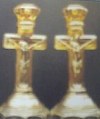Millersburg Stems (More)
MORE MILLERSBURG STEMS

BOUTONNIERE Compote
BOUTONNIERE: Approximately 5” tall, having a bowl diameter of 5”, the stemmed base on this compote is 3” in diameter. The design is very simple when compared to some of the other more complex patterns offered. A single flower having five petals comprises the interior bowl pattern. Variations of bowl shapes include ruffled, while others have edges pulled tight. Some are found to have more flattened bowls with edges that turn up. Colors are amethyst, green and marigold in Carnival Glass. They nearly always have super color and iridescence, whether they be satin or radium finish. Amethyst is most desirable, with the highest market value, but green and marigold are more difficult to locate. These are one of the more reasonably priced compotes. A blue or vaseline example would be an exciting find. The pattern is only found on these small compotes.

DEEP GRAPE Compote in Round Shape
DEEP GRAPE: Referring to our Alphabet on the homepage, you will locate this pattern in an amethyst rosebowl, and a square amethyst compote in another segment. Click on - D -.
A Deep Grape in any shape is a rare find. This round marigold beauty stands 7” tall . The top opening can be 5” - 7”, depending upon its round or square shape. A candy ribbon edge amethyst compote is known. Typical colors are amethyst, green, or marigold. A blue compote has been reported. The only known green rose bowl stands 7 1/8” tall and has a 3 ¾” top opening. It sold in 1991 for $7,000.
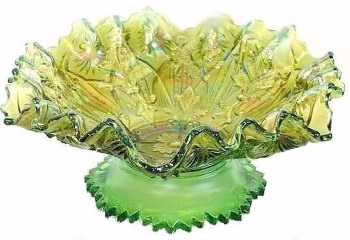 |
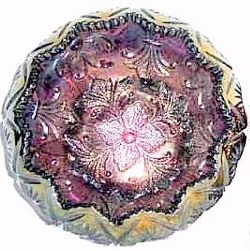 |
FLEUR DE LIS Dome Footed 9 inch Bowl
|
FLEUR DE LIS Rose Bowl Interior
|
FLEUR DE LIS: Exterior pattern on this piece is Country Kitchen. You will find a pretty amethyst collar-base bowl shown in another segment on this site, by going to our Alphabet and clicking on - F - . Also listed there is a footed rose bowl in amethyst. Bowls with the collar base are more difficult to find than those with the domed base. Amethyst, green and marigold are known in Carnival, with one vaseline example reported.
Bowls having domed base are known in deep round shape, or having three and one edge, along with an ice cream shape and a tri-corner bowl having brilliant radium iridescence. These are highly desirable.
At the time Marie McGee wrote her book in 1995, only one compote was known in green. At that time it was in a CA collection, but later found a home in an IL collection. Two different examples of rose bowls (collar base and domed foot) exist. Two examples of each in the amethyst color are known.
 |
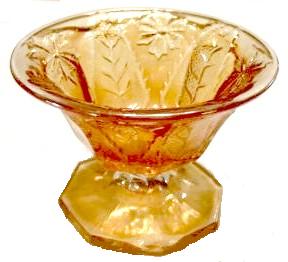 |
HOBSTAR & FEATHER Giant Rosebowl in marigold
|
LEAF & LITTLE FLOWERS Compote in Marigold - 3 inch
|
HOBSTAR and FEATHER: Only a couple of these massive pieces are known in marigold! You can locate a lovely green example by clicking on - H - in our Alphabet pattern index. Amethyst and green are the other colors known in Carnival Glass. The bottom of the stem base has a large hobstar on it. 9” tall and weighing in at 6 pounds, this rosebowl commands attention.
LEAF & LITTLE FLOWERS: In the miniature classification at 3” tall, with a bowl diameter of 3 ¾”, these are found having round or ruffled tops in amethyst, green and marigold Carnival Glass. Marigold is by far the most difficult to locate, but ruffled amethyst and green examples with radium finish usually come with higher prices. This is the same base mould used for the very rare couple of Olympic compotes known.
 |
 |
PEACOCKTAIL Variant Compotes 3.5 inches tall x 6 inch across top
|
|
PEACOCKTAIL Variant: This compote has a very short stem, standing only 3 ¼” tall and having an octagon shaped base, 3” in diameter. The interior pattern consists of a feathered stippled rays effect and a six-petal design. Known colors are amethyst, green and marigold Carnival. This compote has excellent iridescence, whether in satin or a radium finish.

Only blue Tall ROSALIND compote
sold for $15,000 in Aug. 2004
ROSALIND: Referred to as the “tall compote” in this pattern, the blue example is the only one known. It was found by a Los Angeles collector in the 80s, offered for sale at $20,000 at the time. As these rare items tend to do, it evolved through a trade/money exchange with a dealer and then found a home in a prominent collection in Texas for awhile. The sale noted in the photo brought the compote into a new home of appreciation.
By clicking on - R - in our Pattern index, you will find one of two known marigold compotes in this same pattern. Each of these have different characteristics. One has a marigold stem and foot, while the other has clear glass for stem and foot.
One example in amethyst has a round bowl, referred to as a jelly compote.
 |
 |
Small amethyst ROSALIND Compote-notice the notch in the stem.
|
Small ROSALIND Compote in amethyst 5.5 in. tall - rare
|
ROSALIND Small: This 6” tall version can be found in amethyst and green Carnival and is every bit as rare as the taller compotes.
 |
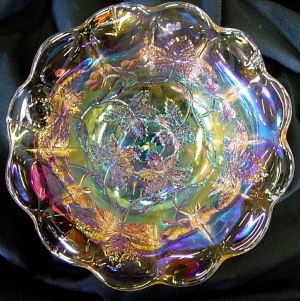 |
WILDFLOWER compote in marigold
|
Interior of WILDFLOWER Compote
|
WILDFLOWER: Eight leaves, eight blossoms and a vine, combine to create a lovely pattern in this rare compote! Very few are known in just two shapes. There is a deep cupped jelly compote which is 6” tall with a 4 ½” bowl opening, and an open flared bowl. The brilliant radium iridescence is found only inside the bowl. Stem and cloverleaf base on the marigold compote is almost clear.
Open bowl examples are known in amethyst (damaged), green, marigold, and a single compote in vaseline Carnival. A purple jelly compote appeared at an auction in 1985.
Dean & Diane Fry - 10/05

As Christians, we often refer to sharing our faith
in Christ as “witnessing” or “giving our testimony.”
It's an accurate concept taken directly from the Bible.
John, a companion and disciple of Jesus, wrote:
“We have seen, and bear witness, and declare to you that
eternal life which was with the Father and was manifested to us
--that which we have seen and heard we declare to you”
(1 John 1:2-3)

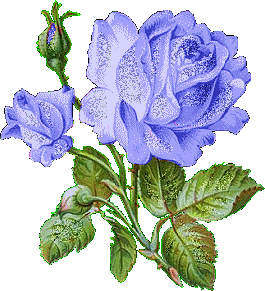
Should you care to contact the Frys, their email address is:
Search Our Sites
back to Carnival Glass 101
Our other sites you may enjoy:
Everything you EVER wanted to know about Indiana Glass
Great Reference for Newer Carnival Glass.
Complete Glassware Catalogs Available to Download
Questions? Comments? Suggestions? Broken Links? Corrections?
Your Friendly Webmaster is here to help!
